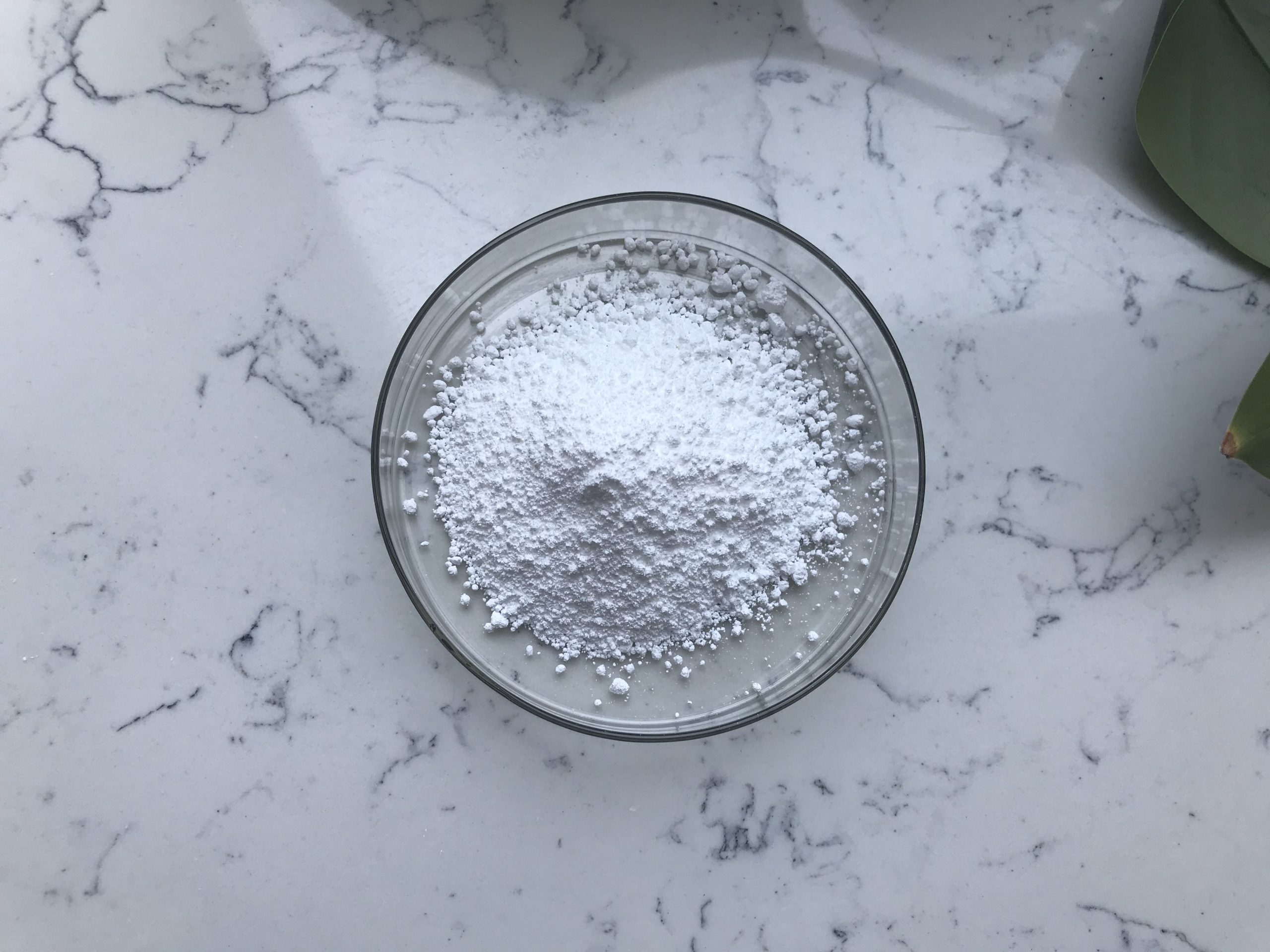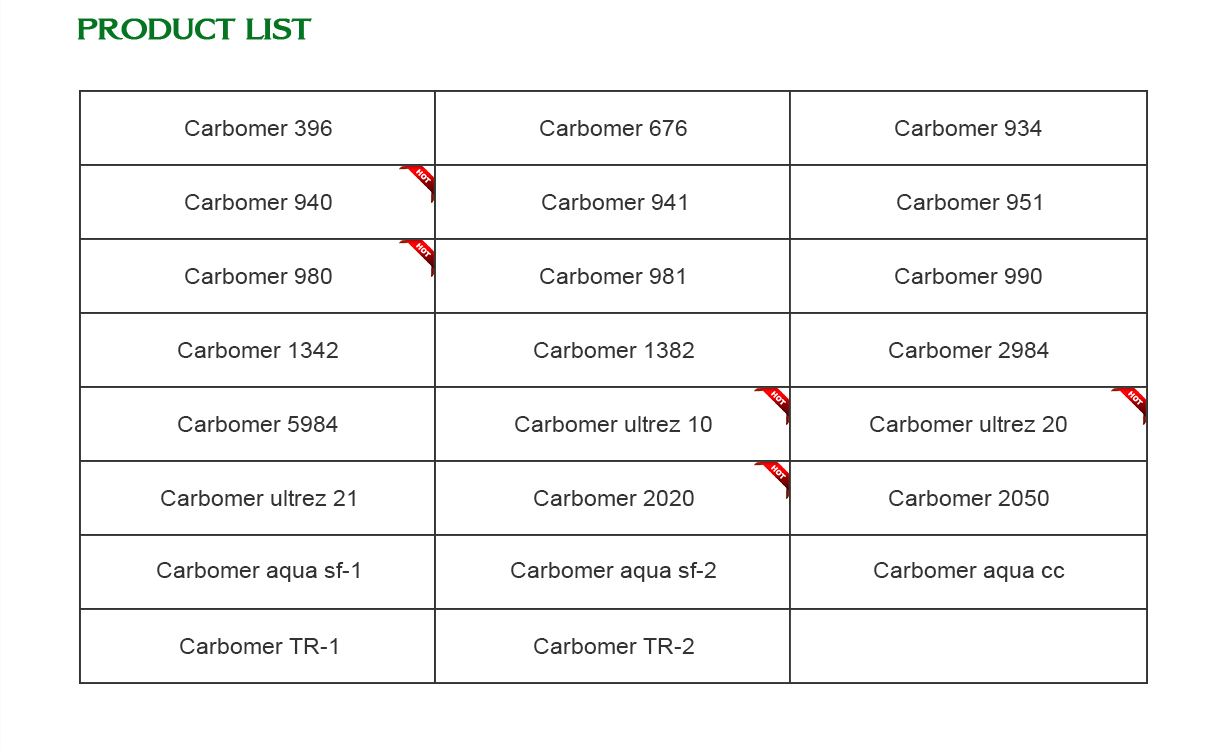Carbomer 940 is a commonly used ingredient in the pharmaceutical and cosmetic industries. It is a high-molecular-weight polymer that is primarily used as a thickening, suspending, and emulsifying agent. Here are the basic components and characteristics of Carbomer 940:
Polymer Structure: Carbomer 940 is a synthetic polymer that consists of acrylic acid cross-linked with a polyalkenyl ether. The cross-linking of acrylic acid molecules results in a three-dimensional network structure.
Appearance: It is usually supplied as a white, fluffy, dry powder.
Solubility: Carbomer 940 is not soluble in water, but it can swell and absorb water to form a gel-like consistency.

Thickening and Gelling: One of the primary functions of Carbomer 940 is to provide viscosity and create gel-like textures in formulations. When dispersed in water or other aqueous solvents, it swells and creates a highly viscous and stable gel or emulsion.
Suspension: Carbomer 940 is used to suspend solid particles or other ingredients within a liquid medium, preventing them from settling at the bottom.
Emulsification: It can help stabilize oil-in-water emulsions, ensuring that oil droplets remain dispersed within the water phase.
PH Sensitivity: The performance of Carbomer 940 is influenced by the pH of the formulation. It is most effective in formulations with a pH range of around 5 to 10. Outside this range, its viscosity and stability may be affected.
Neutralization: To achieve the desired viscosity and gel formation, Carbomer 940 often requires neutralization with an alkaline substance, such as sodium hydroxide (NaOH) or triethanolamine (TEA). This neutralization process disrupts the polymer’s cross-linking and allows it to swell and thicken.
Applications: Carbomer 940 is commonly used in various cosmetic and pharmaceutical products, including gels, creams, lotions, ointments, shampoos, and personal care products. It is employed to improve the texture, stability, and sensory characteristics of these products.
Safety: Carbomer 940 is generally considered safe for topical use, but it should not be ingested or come into contact with eyes, as it can cause irritation.
It’s important to note that specific formulations and usage guidelines may vary depending on the product and manufacturer. If you’re working with Carbomer 940, be sure to follow the recommended procedures and safety guidelines provided by the supplier or regulatory authorities.
Materials and methods for Carbomer 940
Carbomer 940 is a common polymer used in various industries, including pharmaceuticals, cosmetics, and personal care products, as a thickening, suspending, and emulsifying agent. It’s primarily used to create gels and improve the viscosity of liquids. Below, I’ll provide a general outline of the materials and methods for working with Carbomer 940. Keep in mind that specific formulations and procedures can vary depending on the intended application.
Materials:
- Carbomer 940: This is the main polymer that will be used to thicken the formulation.
- Purified Water: Used as the solvent for dispersing the Carbomer.
- Neutralizing Agent: Typically a base like sodium hydroxide (NaOH) or triethanolamine (TEA) is used to neutralize the Carbomer and bring it to its desired viscosity.
- Preservatives: If necessary, preservatives like parabens or phenoxyethanol may be added to prevent microbial growth.
- Other Additives: Depending on the desired properties of the final product, additional ingredients like colorants, fragrances, emollients, and active ingredients may be included.
- Mixing Equipment: Containers, stirrers, and mixers for preparing the formulation.
Methods:
Preparation of Carbomer Gel:
- a. Weigh the required amount of Carbomer 940. The exact amount depends on the desired viscosity and final product volume.
- b. Slowly sprinkle the Carbomer into the purified water while stirring. This helps prevent clumping and promotes even dispersion.
- c. Continue stirring until the Carbomer is fully dispersed. This can take some time, as Carbomer tends to swell and hydrate slowly.
Neutralization:
- a. Slowly add the neutralizing agent (NaOH or TEA) to the Carbomer dispersion. This step raises the pH and neutralizes the polymer, causing it to thicken.
- b. Monitor the pH and viscosity as you add the neutralizing agent. The pH should be adjusted to the desired range, typically around pH 6 to 7.
Incorporation of Additional Ingredients:
- a. Add any preservatives, colorants, fragrances, or other additives to the formulation according to the desired recipe.
- b. Mix thoroughly to ensure even distribution of additives.

Final Adjustments:
- a. Check the viscosity of the gel. If it’s too thick, you can adjust by adding more water or adjusting the neutralizing agent.
- b. If the viscosity is too low, you can prepare a separate Carbomer dispersion with a higher concentration and gradually add it to the main formulation.
Quality Control:
- a. Test the final formulation for its desired viscosity, pH, and overall appearance.
- b. Perform stability tests, including freeze-thaw, temperature, and microbial challenge tests, depending on the intended use of the product.
Remember that these are general guidelines, and the specific procedures may vary based on the intended application and the formulation requirements. Always consult the specific guidelines and regulations for the industry you’re working in and consider seeking guidance from experts or professionals in that field.
